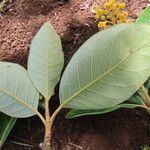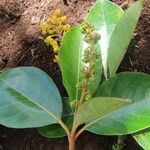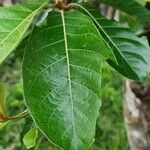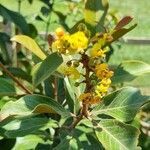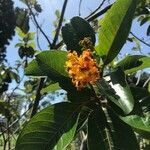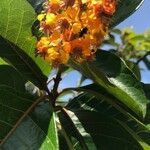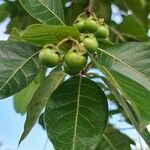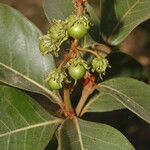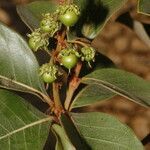Tree, 4-13(-15) m tall, 15-30 cm d.b.h.; bark fissured and lenticellate; wood dull reddish-brown, hard, heavy; younger parts densely downy-tomentose, sparsely tomentose on upper leaf surface and becoming glabrate; stems with prominent leaf scars. Leaves opposite, obovate to elliptic or ovate, short-acu-minate, acute to obtuse at base, 4-15 cm long, 2-9 cm wide, densely pubescent below with stalked trichomes, glabrescent except the midrib; midrib arched; pet-ioles 0.5-1.5 cm long, stout. Pseudoracemes terminal, usually solitary, usually unbranched, sometimes with few short branches near the base, to 20 cm long; axes, branches, peduncles, bracts, and sepals densely pubescent when young, becoming glabrate; bracts ovate-lanceolate, 2-4 mm long, deciduous; bracteoles ovate, acute, 1.0-1.5 mm long; pedicels to 1.5 cm long; flowers many, yellow, becoming red-orange in age; sepals 5, 1.5-2.5 mm long, blunt, recurved, glabrous inside, each bearing 2, thick, oblong-ovoid glands; petals clawed, 10-13 mm long, glabrous, the blade suborbicular, concave, more or less equalling length of claw, the margin irregular, one petal often smaller and held somewhat erect, the others spreading to reflexed; stamens 10, 4-5 mm long, the filaments hispid at the base, the anthers introrse, 2.5-3.0 mm long, the thecae prominently raised shedding pollen in bud, the connective thickened; ovary usually pubescent, the styles 3, distinct, slender, slightly longer than or equaling the stamens, persisting on young fruits. Drupe ovate-globose, glabrous, 0.8-1.5 cm in diam., green turning yellow to reddish; pyrenes 1-3.
More
A medium sized evergreen tree. It grows 2-10 m tall. The bark is cracked. The leaves are simple and opposite. They are 7-15 cm long by 3-7 cm wide. They are rich green and shiny but paler underneath. The veins and leaf stalks are a rusty red colour. The flowers are rich yellow and have a crumpled appearance. The flowers are held in erect, hairy racemes. These are 6-15 cm long. The fruit are small and sweet and green when young but orange-yellow when ripe. They are 1-5 cm across. They have an aroma. They have a thin skin and white, juicy pulp.
